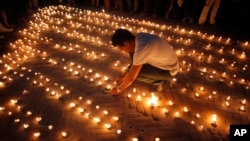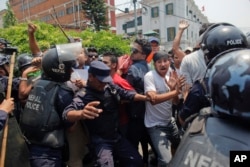Thousands of Nepalis marked the one-year anniversary Sunday of the Himalayan country's devastating earthquake, grieving for the loss of nearly 9,000 people in the midst of lagging reconstruction that has left 4 million survivors in temporary shelters.
Prime Minister Khadga Prasad Oli placed a wreath at the ruins of the Dharahara tower in the heart of the capital, Kathmandu.
The tower collapsed in the April 25, 2015, disaster, killing 132 people at the landmark site.
Tower's collapse
Madhav Newpane, a shop owner near the tower who saw it collapse, brought flowers and candles to the commemoration.
"There were many people killed here on that day," Newpane said. "I will never be able to forget that day."
At the nearby Durbar Square, a dozen crimson-robed monks chanted from Buddhist scriptures as the victims' relatives sat crossed-legged, praying in front of framed portraits of their loved ones.
However, about 100 protesters clashed with riot police outside Oli's office, demonstrating against the slow pace of the Nepalese recovery.
More than 600,000 homes were destroyed in the magnitude-7.8 quake that upended roads in the country and turned mountain villages into rubble.
"Government, where is reconstruction," the protesters chanted as they tried to force their way through a police barricade. "Open the gates of the government."
International aid
International donors have pledged $4.1 billion toward Nepal's recovery, but only $1.3 billion has been sent to the country so far, with the government blamed for taking months to set up the National Reconstruction Authority, which was only completed in December.
Homeless survivors have been promised about $2,000 in aid, but only several hundred have received the first $500 installment.
One Red Cross official in Nepal said, "We are hoping that the government's priorities and perspectives on reconstruction will soon be clear so that we can help people to rebuild and get their lives back on track as quickly as possible."
Tibetans remain displaced
According to reports by VOA's Tibetan Service, Tibetan villages along Nepal's border, which were also destroyed by that same quake, have yet to be rebuilt, and many of an estimated 100,000 internally displaced Tibetans remains without homes to return to.
On Friday, Tibet Radio, a Chinese official Tibetan language news service, indicated most relocated Tibetans still remain in Shigatse, Tibet's westernmost prefecture-level city. The state newscaster also said Pema Trinlay, vice party secretary of Tibetan Autonomous Region, recently visited the displaced Tibetans and told them that quake reconstruction is a top priority in 2016.
It is not clear whether the construction will focus on rebuilding damaged homes or simply moving displaced Tibetans into newly towns, as Beijing has done before.
Yeshi Dorje of VOA's Tibet Service contributed reporting from Washington.











